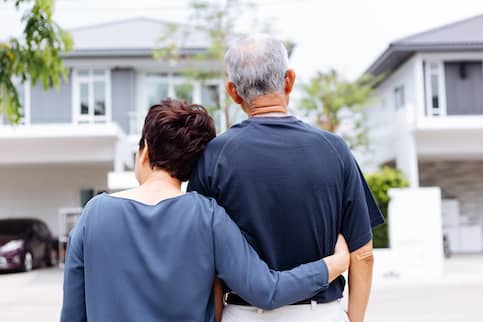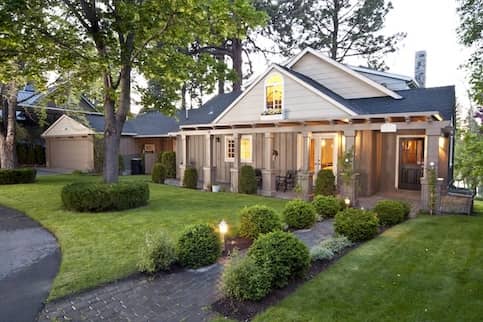Housing isn’t cheap, especially with the cost of electricity increasing faster than inflation in recent years. Of course, there are small cost-saving measures you can take, like turning off the air-conditioning when you’re not home and installing low-flow faucets. However, if you’re highly motivated to reduce emissions and energy costs, you might consider purchasing or building a net-zero home.
Key Takeaways:
- A net-zero home produces as much energy as it consumes by using efficient design and building systems.
- Net-zero homes don’t just benefit the planet by reducing greenhouse gas emissions; they can also lower your energy costs and offer energy independence during outages.
- Net-zero homes may be more expensive to build or purchase, but an Energy Efficient Mortgage can help you qualify for a larger loan.
What Is A Net-Zero Home?
A net-zero home is a home that generates as much energy as it consumes. It does so with a combination of energy-efficient design and building systems. The result? A sustainable, carbon-neutral home with no long-term energy costs.
There’s no one-size-fits-all net-zero home. They can have varying styles and sizes, and they can exist in a wide range of locations.
Net-Zero Homes Vs. Other Energy-Efficient Homes
While both save energy, there is a difference between a net-zero home and an energy-efficient home. Net-zero homes produce as much energy as they consume. Energy-efficient homes may reduce energy consumption, but they don’t necessarily generate their own renewable energy.
Here’s how different types of energy-efficient homes compare to net-zero homes:
- Net-zero homes vs. off-grid homes: Off-grid homes are entirely disconnected from the traditional power grid and rely solely on renewable energy sources for their energy needs. On the other hand, net-zero homes are still connected to the grid. While net-zero homes are designed to produce all the energy they need, they may even produce excess energy, which they can export back to the grid.
- Net-zero homes vs. passive homes: Passive homes are designed to minimize energy consumption through efficient insulation, construction and ventilation systems. Though they may be highly energy-efficient, passive homes don’t necessarily generate their own energy. Net-zero homes, on the other hand, produce enough energy to be self-sufficient.
Compare Mortgage Offers From Verified Lenders:
Key Elements Of A Net-Zero Home
A lot goes into building a net-zero home. Below are some of the key elements that make net-zero homes efficient and allow them to generate their own energy:
Appropriate Location
The location of a net-zero home plays a critical role in its energy efficiency. Ideally, net-zero houses are built in places that have ample access to renewable energy sources – such as direct sunlight for solar panels, proximity to water for hydropower, or strong winds for wind turbines.
Intelligent Design
Just like the location, the overall architectural layout of a net-zero home contributes to its energy efficiency. This includes strategic placement of windows to maximize natural light and ventilation as well as the use of energy-efficient appliances and fixtures.
Renewable-Ready
A net-zero home needs the infrastructure to accommodate renewable energy systems like solar panels, wind turbines and hydropower systems. For example, the roof must be structurally capable of supporting solar panels, and the electrical system should be capable of handling the energy generated by those solar panels.
Energy-Efficient Appliances
Energy-efficient appliances, such as ENERGY STAR-rated refrigerators, washing machines and HVAC systems, are a key component of net-zero houses. These appliances meet strict energy efficiency criteria set by the U.S. EPA. Incorporating these appliances can reduce your home’s energy output by 77,000 pounds of greenhouse gas emissions over their lifetime.
High-Quality Insulation
High-quality insulation not only keeps you comfortable, but it also minimizes heat gain or loss and decreases the energy needed to heat or cool your house. Net-zero homes need high-quality insulation materials and energy-efficient windows to reduce energy loss effectively. This helps to create an airtight and well-insulated building envelope, minimizing the energy required to maintain a comfortable temperature.
Water Management
Strategic water management can both conserve resources and reduce the potential for water damage in a home. Some ways net-zero homes can do this include using low-flow water fixtures, stacked plumbing, drain water heat recovery, and hot water recirculation.
Smart Home Monitoring
Smart home monitoring systems are becoming increasingly popular in net-zero homes, as they allow homeowners to track and optimize their energy use in real time. These systems show homeowners their energy consumption patterns, helping them make informed decisions about their energy use.
Home Energy Certification
Getting a home energy certification, such as Leadership in Energy and Environmental Design or ENERGY STAR, provides an independent verification of a home’s energy performance and environmental impact, giving owners of net-zero homes confidence in their investment.
What’s Your Goal?
Buy A Home
Discover mortgage options that fit your unique financial needs.

Refinance
Refinance your mortgage to have more money for what matters.
Tap Into Equity
Use your home’s equity and unlock cash to achieve your goals.
Benefits Of Net-Zero Houses
There are several benefits to buying or building a net-zero home. Consider the following advantages:
Environmental Sustainability
Net-zero homes appeal to some homeowners for their positive impact on the environment. With their energy-efficient features and ability to generate clean and renewable energy on-site, these homes reduce reliance on fossil fuels and decrease greenhouse gas emissions.
Healthier Homes
Net-zero homes are built to be airtight and well-insulated, preventing drafts and potential pollutants indoors. Additionally, net-zero homes often use advanced ventilation systems, which continuously exchange fresh air and filter out contaminants.
Energy Cost Savings
Building a net-zero house can be expensive, but it comes with lower ongoing costs. Because the buildings are incredibly energy efficient and produce all the energy they consume, you’ll pay nothing, or next to nothing, when it comes to electricity. Plus, the construction costs might not be as high as you think. For example, the cost of renewable energy systems, such as solar panels, has decreased in recent decades.
Green Tax Credits
In recent years, federal tax law gave homeowners a 30% tax credit on the costs of new, qualified clean energy property (such as solar electric panels and geothermal heat pumps). While these incentives are set to expire at the end of 2025 as part of the One Big Beautiful Bill Act, there may still be money available from states and utility companies. The Database of State Incentives for Renewables and Efficiency is a good place to look.
Increased Resale Value
Net-zero homes typically have a higher resale value than conventional homes. As awareness and demand for energy-efficient, cost-effective and sustainable housing continue to grow, these homes are becoming increasingly sought after in the real estate market.
Independence
With a growing number of natural disasters causing more power outages across the country, net-zero homes can offer reliability and independence. When paired with battery storage or backup systems – and because they use less energy to begin with – net-zero homes can maintain comfortable temperatures and support the use of household appliances during an outage.
Ready To Become A Homeowner?
Get matched with a lender that can help you find the right mortgage.
Disadvantages Of Net-Zero Homes
Although you can save big on energy bills with a net-zero house, the incorporation of energy-efficient features and renewable energy systems can be expensive up front, costing 4% to 8% more than a conventional home to build. (Note that these figures may increase when federal tax credits expire at the end of 2025.)
Building a net-zero house may come with its own challenges, like finding skilled contractors experienced in this type of construction. Specialized knowledge and expertise are required to ensure that the house is well-designed, energy-efficient and meets the necessary performance standards. If you decide to build a net-zero house, it’s wise to seek out professionals who have experience in sustainable building practices.
Getting A Mortgage For A Net-Zero Home
Getting a mortgage for a net-zero home is similar to securing financing for a conventional home. However, you can look for a lender that offers Energy Efficient Mortgages, which can help you qualify for a larger loan or better financing terms.
You should also ensure the home’s assessed value considers all its energy upgrades, as these can increase the value of the house. For this reason, it’s smart to work with a lender that’s familiar with net-zero homes.
Take The First Step To Buying A Home
Find a lender that will work with your unique financial situation.
The Bottom Line: Going Green With A Net-Zero Home May Save You Money
While it may be more expensive up front, there are several potential benefits to living in a net-zero home. If you’re looking to minimize your carbon footprint while living in a safe, comfortable and durable home – and potentially save money in the process – a net-zero house could be a perfect fit.

Emily Batdorf
Emily Batdorf is a personal finance writer with five years of experience working with clients like Forbes Advisor, Yahoo! Finance, Credible, Experian and more. With a background in education, Emily loves making complex financial topics accessible to the public. She's written and edited hundreds of articles about budgeting, debt, banking and lending. In addition to writing, Emily is also a co-host of The Finance Girlies podcast, where she celebrates financial conversations among Millennial and Gen Z women.












